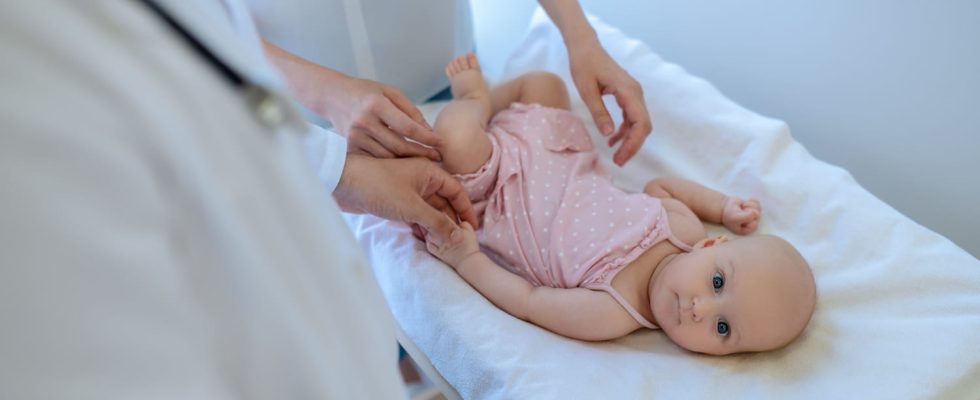Ectodermal dysplasias (ED) form a group of about 100 rare diseases. They are characterized by damage to the teeth, skin, hair, nails, etc. What are the causes of these diseases? How are they diagnosed? What are the possible treatments ?
What is the definition of ectodermal dysplasia?
Ectodermal dysplasias are a set of rare diseases. They are characterized by damage to at least two derivatives of the ectoderm, what are hair, body hair, skin, nails, teeth and sweat glands. Other organs may be affected such as the mammary glands, saliva, cornea and lacrimal glands. According to the High Authority for Health (HAS), the worldwide incidence of this disease is estimated at 1 case per 100,000 people.
What is anhydrotic ectodermal dysplasia?
It is the most common ED, its incidence rising between 4 and 10/10,000 births. It is characterized by thetotal or partial absence of sweat, teeth (when they exist, they are conical), hair and hair. Eyelashes and eyebrows are rare and sparse. Affected people sweat little or not at all, which often makes them heat intolerant : temperature peaks lead to hyperthermia. This disease can also affect the lacrimal glandsleading an absence of tears (the eyes are dry), responsible for illnesses such as conjunctivitis and keratitis. Vision should therefore be closely monitored. The glands present in the pulmonary mucous membranes can also be very reduced, which can cause lung infections, asthma. Finally, the skin of people suffering from this disease is often dry, eczematousespecially in childhood.
What is hypohidrotic ectodermal dysplasia?
“Medical specialists speak of hypohidrotic ED in the event that there is a little sweating, because they have found that sometimes there is a very slight sweating in the handsface, back, or feet…“, specifies Franck Vermant.
What is the dental involvement of hypohidrotic ectodermal dysplasia (DEH)?
DEH is a disease that also affects the teeth. “It is characterized by the absence of at least 7 of them as well as morphological damage, because they take the form of a cone“, says Franck Vermant.
What causes ectodermal dysplasia?
These diseases are of genetic origin. “They are due to a mutation on a gene carried either on an autosomeor on the X chromosome, explains Franck Vermant. For X-linked DEH (the most frequent form, 70% of DEH cases), boys carrying the mutation have a complete form of the disease while women have an attenuated form, most of the time, they only have mild dental damage, decreased sweating and thin hair“.
What is the life expectancy in case of ectodermal dysplasia?
With appropriate and early management, patients have a normal life expectancy.
What are the symptoms of ectodermal dysplasia?
The main manifestations of the disease are:
- A decrease or absence of sweating;
- An absence of several teeth or even the total absence;
- A quantity of reduced saliva;
- A narrow nose and upper jaw, as well as a domed forehead;
- Of the eyes wide apart and far apart;
- A drought skin and eyes;
- Of the absent or thickened nails;
- A low body hair and fine hairsparse and usually very clear;
- Can also be added ENT disorderssuch as nasal obstruction as well as inflammation and infections of the respiratory tract, due to an absence of secretions in the nose.
Diagnosis is made by a physical examination, especially in the skin and teeth because the absence of temporary times in children and an anomaly in their shape are characteristic signs of the disease. It is also very often the dentists who warn about this pathology. A genetic analysis is indicated to confirm the disease.
What treatment to treat ectodermal dysplasia?
To date, there is no curative treatment. “A treatment in phase II of experimentation for carriers of X-linked DEH is ongoing. It mainly allows restore sweating functionwhich overcomes the possible complications“, tells us Franck Vermant. The management must be multidisciplinary. A team made up of a dermatologist, pulmonologist, dental surgeon, psychologist and geneticist take care of the patient. The laying of dental prostheses is possible and recommended from the age of two and a half and should change regularly as it grows. Protect your skin and moisturize it well is also essential, as well as the regular instillation of eye drops to moisturize them and make up for the lack of tears
Thanks to Franck Vermant, expert with the French Association of Ectodermal Dysplasias.
